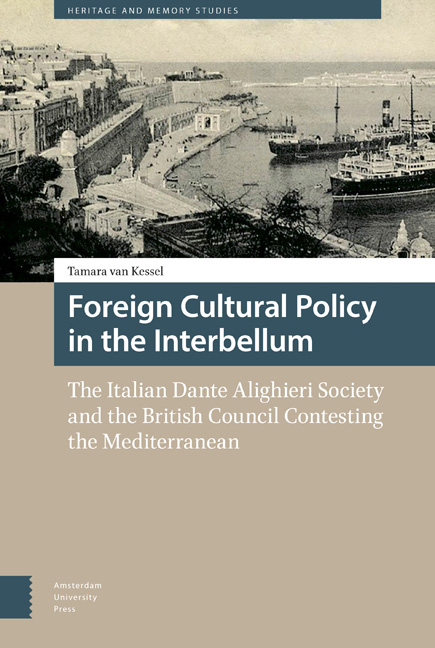 Foreign Cultural Policy in the Interbellum
Foreign Cultural Policy in the Interbellum Book contents
- Frontmatter
- Contents
- List of Illustrations
- Introduction
- 1 The Development of Foreign Cultural Policy
- 2 The Dante Alighieri Society and the British Council: Agency and Independence
- 3 Constructions of ‘Italianità’ and ‘Britishness’
- 4 The Battle for Cultural Hegemony in Malta
- 5 National Culture and Imperial Conquest: The Dante Alighieri Society in Abyssinia and the British Council in Egypt
- Conclusion
- Acknowledgements
- Bibliography
- Index
- Frontmatter
- Contents
- List of Illustrations
- Introduction
- 1 The Development of Foreign Cultural Policy
- 2 The Dante Alighieri Society and the British Council: Agency and Independence
- 3 Constructions of ‘Italianità’ and ‘Britishness’
- 4 The Battle for Cultural Hegemony in Malta
- 5 National Culture and Imperial Conquest: The Dante Alighieri Society in Abyssinia and the British Council in Egypt
- Conclusion
- Acknowledgements
- Bibliography
- Index
Summary
In his seminal study on cultural internationalism, the historian Akira Iriye forcefully argues that, after the First World War, international relations gained a cultural dimension. He focusses on private individuals and groups of people seeking to create an international community through cultural and academic cooperation and exchange. These initiatives were meant to promote mutual understanding and to redefine international relations in non-military terms. The up-and-coming mass-communication technology gave the cultural bridge builders reason to believe that such projects would be feasible. Although in the 1930s, military conflict and extreme nationalism returned with a vengeance, even then ‘the cultural underpinnings of international relations were never lost sight of, in the totalitarian states as elsewhere.’ Indeed, as the interwar history of the Dante Alighieri Society and the British Council has shown, the same technology and awareness of the potential of culture as a global binding force went hand in hand with what may be termed ‘international nationalism’. It encouraged private organizations and governments, totalitarian and democratic, to spread their own nation's language and culture abroad to influence foreign public opinion. This confirms that (cultural) internationalism and nationalism cannot be seen as separate strands in history, for they respond to the same historic circumstances and are entangled with each other.
In the interwar period, cultural activities became an established feature of nation-states’ international politics. This is illustrated by the history of the Allgemeiner Deutscher Schulverein/Verein für das Deutschtum im Ausland, the Alliance Française, and the Società Dante Alighieri – private organizations that at the end of the nineteenth century began to promote their respective national language and culture beyond their home country's borders. As private organizations, they cultivated and took pride in their apolitical image, even if they received government funding. Regardless of the kind of state they functioned in, all would witness an increased activity by the state in the domain of foreign cultural promotion. This was already noticeable after the turn of the century but became particularly pronounced after the First World War. By the time the Treaty of Versailles was signed in 1919, it had become clear that the ongoing process of democratization and the development of new communication technology had made influencing public opinion an important factor in international relations.
- Type
- Chapter
- Information
- Foreign Cultural Policy in the InterbellumThe Italian Dante Alighieri Society and the British Council Contesting the Mediterranean, pp. 225 - 234Publisher: Amsterdam University PressPrint publication year: 2016


